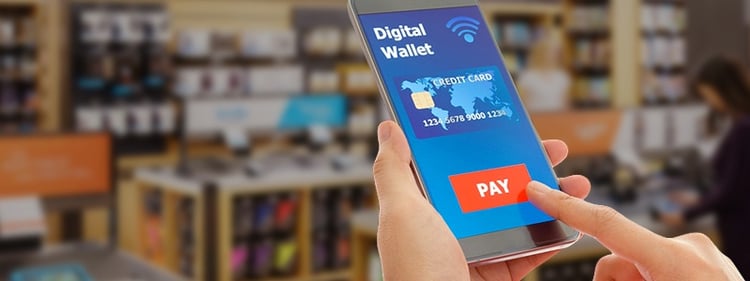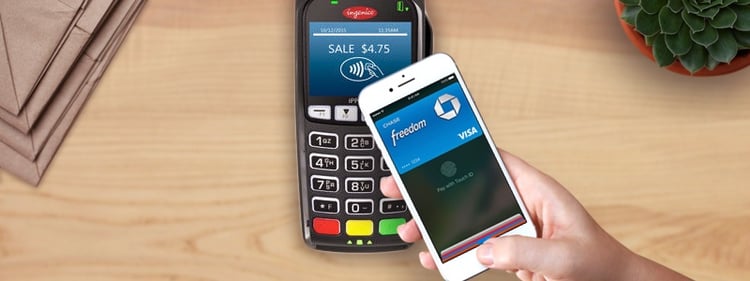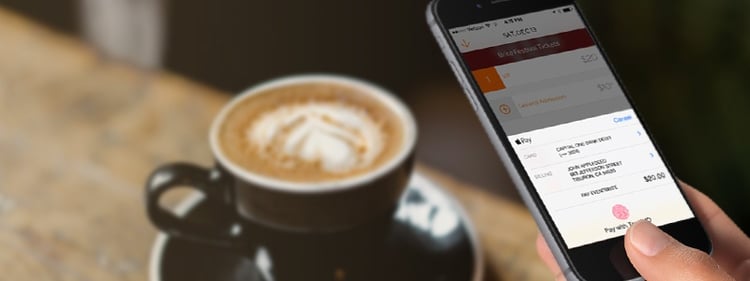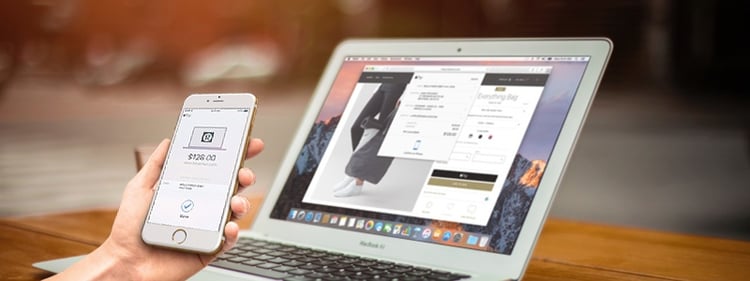
Apple Pay® continues to be on the rise. More merchants than ever are seeing the benefits of including it as a payment option – added convenience, improved customer experience, loyalty program opportunities and more. A recent survey determined that 36 percent of U.S. merchants accept Apple Pay and about 27 percent of eligible U.S. consumers have used it.
But, besides all the hype, the most important consideration is: what are the benefits of Apple Pay and should you include it at your place of business? Here’s a bite-by-bite description of what you need to know to make a smart decision.
What is Apple Pay?
Most likely you have seen a logo or heard the term, but you may not know much about it. Maybe you’re not techy, or maybe you’ve always been an Android user. In case you don’t know, Apple Pay is a digital wallet that allows users to make payments with iPhone®, Apple Watch®, iPad® and MacBook Pro®, in a store, within apps, and online. If you want to know the specific Apple devices that allow a purchase with Apple Pay, view the full list of models.

How does Apple Pay work for merchants and customers?
- NFC, in store
If you have a store with a POS terminal that is enabled with Near Field Communication (NFC), an iPhone (or Apple Watch) with Apple Pay can allow a contactless payment through a type of radio frequency. A customer simply places his or her mobile phone near your POS and authorizes the payment with a passcode, Touch ID (fingerprint), or Face ID (facial recognition), depending on the model of iPhone and phone settings. The payment occurs in a second or two––really.

- In-app, in store
Apple Pay can also work within an app developed for your business. For example, let’s look at how the Starbucks app works, as experienced by an in-store customer with an iPhone.
After the person has downloaded the app onto the iPhone and opens it, the app prompts the customer to load a Starbucks loyalty card with funds, such as $10 or $25. The customer places an order at the counter. The app then prompts the person to “Pay” Starbucks with Apple Pay. The Starbuck’s employee simply scans the QR code displayed on the phone, and, with one or two taps or clicks, a customer pays for her grande cappuccino and tips the barista. It’s easy and instant. And it all happens on the customer’s iPhone––or iPad.

- In-app, at home
Customers can also make in-app purchases with Apple Pay on iPhone and iPad from the convenience of their homes. If you have an eCommerce site, you can set up your app with Apple Pay as another payment option. This adds convenience and security to transactions, which benefits you and your customers.

- Online, with Safari
The iPhone, iPad and newer MacBook Pro models allow for Apple Pay while browsing with Safari. Your web developer can make sure your business sets up Apple Pay as an option at checkout––no app necessary.

The benefits of Apple Pay at a glance
You’re probably already seeing a lot of benefits to Apple Pay, just by describing how it functions between customer and merchant. But let’s go over some of the more obvious benefits.
- Convenience.
Today’s customers––especially younger, more tech-savvy ones––may not carry wallets when they leave the house, but will certainly remember to bring their mobile phones. And, Apple has also made it simple to set up Apple Pay in the iPhone.
It’s as easy as opening the Apple Wallet app and taking a photo of a credit card. The issuing bank authenticates the card, and it’s ready to use within a few minutes. It’s also convenient for you as a merchant, since you and your employees don’t need to take cards, swipe cards, examine cards or wait for cards to process. Apple Pay happens instantly without much work on the merchant’s part.
- Faster payments.
Sync up convenience with fast and easy, and you have a winner. A customer will walk away from a long line, especially one that doesn’t seem to be moving. However, when customers and merchants are using Apple Pay, lines can move a lot faster, which means more revenues during the busiest times of day. It’s a big help if merchants educate their employees about Apple Pay to facilitate its expedience and customer experience. See more about that below.
- Apple Pay adoption rates are increasing.
Statistically, the U.S. market share of mobile phones is closely split between Android and Apple, 53% and 45% respectively. However, Apple Pay is being adopted more readily than other types of contactless payments such as Android Pay and Samsung Pay. According to recent numbers, Apple Pay accounts for 90% of contactless payments where it’s available. And it is available everywhere you turn and each day more merchants are adopting it as a secure and convenient way for their customers to pay.
- Loyalty programs can help grow business.
Your business can set up rewards cards linked to Apple Pay, like the Starbucks app does in the case above. If you want to build loyalty at one location, have a franchise or are considering expanding to another location, an app with a rewards program that accepts Apple Pay would be a smart way to build your business.
Are you ready to accept Apple Pay?
Do you have an NFC-enabled POS?
First of all, if you have a location-based business, such as a retail store, coffee shop or restaurant, you’ll need an NFC-enabled POS device or devices. How do you know if yours fits the bill? Contact your payments processor or merchant account provider, and ask if your device is NFC-enabled. Newer EMV-enabled chip cards have NFC capability built in, but your provider may need to turn it on to accept Apple Pay. Beyond that, you’re POS is ready to go. And Apple doesn’t charge you to accept payments with its Apple Pay service, so you don’t have to worry about extra fees.

Are your employees ready?
A little Apple Pay employee training could go a long way when trying to get it operating efficiently in-store. Here are a few ideas:
- Get employees involved. If employees start using Apple Pay themselves, they’ll better understand it.
- Hold an in-store mini class. And we do mean “mini,” because it won’t take long for employees to learn about Apple Pay. It’s a simple process, and employees can practice checkout on each other.
- Teach employees how to accept returns. If they know how to accept Apple Pay returns, they’ll be even more likely to suggest it for payments.
- Get them talking. Make it mandatory that your employees mention Apple Pay a certain number of times throughout the day.
- Put up Apple Pay decals. Apple will send you signs for your store window and checkout. Just ask!
- Talk to your developer. If you sell online, operate ecommerce only, or want an app developed for your business, discuss it with your developer. It can make checkout easy and more secure.
Is Apple Pay really secure?
It’s a top concern for consumers and merchants, and is possibly the greatest obstacle to adoption: the security question. Or rather, questions. How can the cards stored on your phone be secure? What if you lose your phone? Who’s responsible: banks or merchants or consumers?
While the answers are still sorting themselves out, it seems everyone has an interest in making Apple Pay secure––especially Apple. According to the company, it is more secure than traditional cards. Here’s why:
- The card issuing bank encrypts your card data so the numbers are never stored on your Apple devices.
- The Secure Element chip stores the encrypted information within your Apple devices.
- Authentication by passcode, fingerprint or facial recognition is required to access and use Apple Pay.
- If a person loses a phone, a passcode is required to get into it. Or, if “Find My Phone” is turned on, a person can suspend the Apple Pay account by placing device in “Lost Mode.”
Customer experience is the greatest benefit.
“Exceptional.” That’s the word every merchant would like attached to their customer experiences and reviews. And Apple Pay may help make a great experience exceptional, whether in-store, in-app or online. The convenience, speed and ease makes Apple Pay desirable for customers, and merchants want to make customers happy.
As of now, it seems that Apple Pay is slowly but surely shifting the way people pay.
Andrew Wind is the Principal Product Manager, Digital Wallets at Vantiv, now Worldpay
(This article was originally published on Vantiv's blog)










